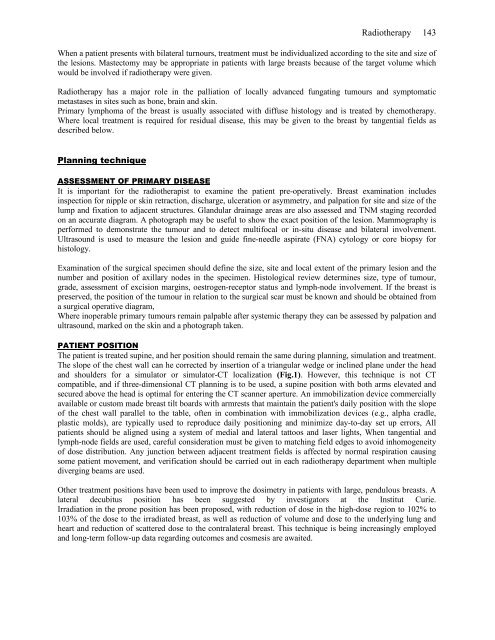Breast Cancer - Arab Medical Association Against Cancer
Breast Cancer - Arab Medical Association Against Cancer
Breast Cancer - Arab Medical Association Against Cancer
- No tags were found...
You also want an ePaper? Increase the reach of your titles
YUMPU automatically turns print PDFs into web optimized ePapers that Google loves.
Radiotherapy 143When a patient presents with bilateral turnours, treatment must be individualized according to the site and size ofthe lesions. Mastectomy may be appropriate in patients with large breasts because of the target volume whichwould be involved if radiotherapy were given.Radiotherapy has a major role in the palliation of locally advanced fungating tumours and symptomaticmetastases in sites such as bone, brain and skin.Primary lymphoma of the breast is usually associated with diffuse histology and is treated by chemotherapy.Where local treatment is required for residual disease, this may be given to the breast by tangential fields asdescribed below.Planning techniqueASSESSMENT OF PRIMARY DISEASEIt is important for the radiotherapist to examine the patient pre-operatively. <strong>Breast</strong> examination includesinspection for nipple or skin retraction, discharge, ulceration or asymmetry, and palpation for site and size of thelump and fixation to adjacent structures. Glandular drainage areas are also assessed and TNM staging recordedon an accurate diagram. A photograph may be useful to show the exact position of the lesion. Mammography isperformed to demonstrate the tumour and to detect multifocal or in-situ disease and bilateral involvement.Ultrasound is used to measure the lesion and guide fine-needle aspirate (FNA) cytology or core biopsy forhistology.Examination of the surgical specimen should define the size, site and local extent of the primary lesion and thenumber and position of axillary nodes in the specimen. Histological review determines size, type of tumour,grade, assessment of excision margins, oestrogen-receptor status and lymph-node involvement. If the breast ispreserved, the position of the tumour in relation to the surgical scar must be known and should be obtained froma surgical operative diagram,Where inoperable primary tumours remain palpable after systemic therapy they can be assessed by palpation andultrasound, marked on the skin and a photograph taken.PATIENT POSITIONThe patient is treated supine, and her position should remain the same during planning, simulation and treatment.The slope of the chest wall can he corrected by insertion of a triangular wedge or inclined plane under the headand shoulders for a simulator or simulator-CT localization (Fig.1). However, this technique is not CTcompatible, and if three-dimensional CT planning is to be used, a supine position with both arms elevated andsecured above the head is optimal for entering the CT scanner aperture. An immobilization device commerciallyavailable or custom made breast tilt boards with armrests that maintain the patient's daily position with the slopeof the chest wall parallel to the table, often in combination with immobilization devices (e.g., alpha cradle,plastic molds), are typically used to reproduce daily positioning and minimize day-to-day set up errors, Allpatients should be aligned using a system of medial and lateral tattoos and laser lights, When tangential andlymph-node fields are used, careful consideration must be given to matching field edges to avoid inhomogeneityof dose distribution. Any junction between adjacent treatment fields is affected by normal respiration causingsome patient movement, and verification should be carried out in each radiotherapy department when multiplediverging beams are used.Other treatment positions have been used to improve the dosimetry in patients with large, pendulous breasts. Alateral decubitus position has been suggested by investigators at the Institut Curie.Irradiation in the prone position has been proposed, with reduction of dose in the high-dose region to 102% to103% of the dose to the irradiated breast, as well as reduction of volume and dose to the underlying lung andheart and reduction of scattered dose to the contralateral breast. This technique is being increasingly employedand long-term follow-up data regarding outcomes and cosmesis are awaited.









